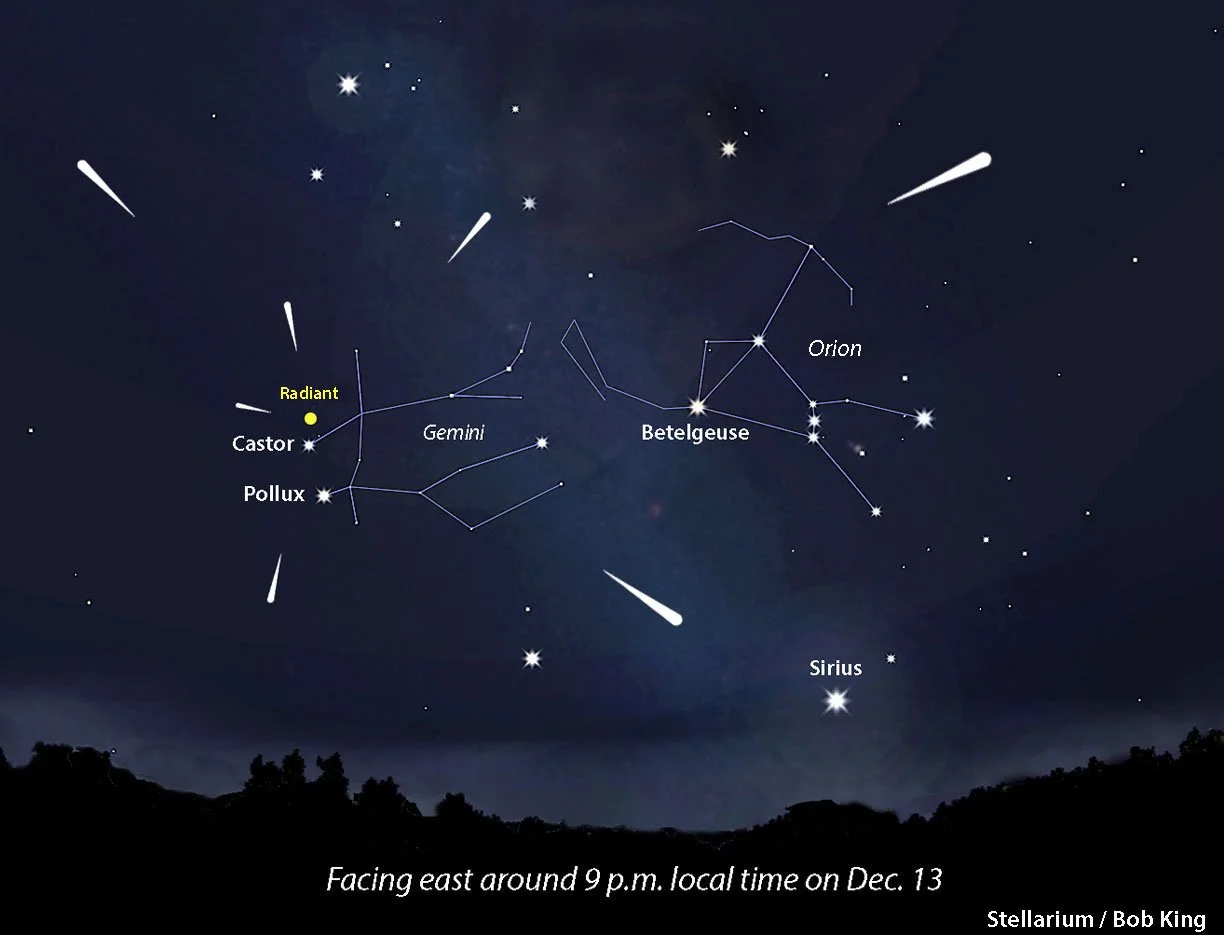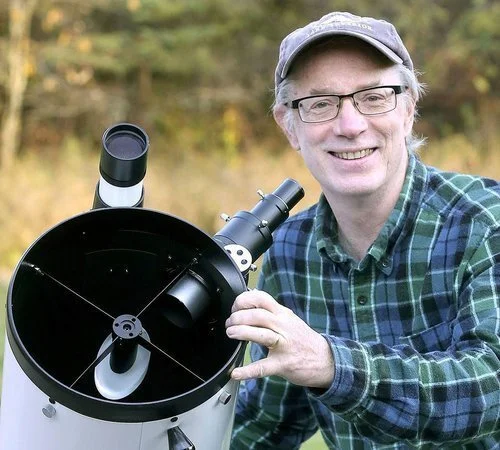December 2023 Night Sky Calendar
Brr! It’s cold. Yet the stars are like tiny sparks of fire that warm the heart. The new season brings a host of new luminaries to the night sky with Orion in the vanguard. He awakens in the east around 8 o’clock early in the month and at 6:30 by month’s end. The Hunter brings his brightest stars Betelgeuse and Rigel to the table. Sirius the Dog Star and Procyon the little dog follow soon after.
December’s biggest event is the annual Geminid meteor shower which originates from the asteroid Phaethon. Phaethon may be a comet on the verge of extinction, yet it still flakes dust now and again as it passes near the sun every year and a half. Earth plows headlong into that debris trail every December. As the shards strike the atmosphere they flare as meteors.
Saturn still puts on a good show during the evening hours, appearing midway up the southern sky as soon as it gets dark. But it’s moving westward, departing center stage to make way for the bright king of the planets Jupiter. Jupiter stands high in the south in December in a commanding position. The planet will be even more obvious when joined by the moon on Dec. 21 and 22.
Venus still dominates the morning sky at dawn in the constellation Virgo while Mars and Mercury are too close to the sun to see.
Happy solstice and keep cozy!
Events (a.m. indicates the event happens in the dawn sky):
Dec. 4 – The last quarter moon will rise around midnight and appear high in the southern sky near sunrise. Sometime in the next two weeks point your binoculars at the Seven Sisters Star Cluster (a.k.a. the Pleiades) high in the southeastern sky a couple fists to the left of brilliant Jupiter. You’ll be amazed at how many stars you can see.
Dec. 8 (a.m.) – The waning crescent moon floats 2.5 degrees above Spica, Virgo the Virgin’s brightest star.
Dec. 9 (a.m.) – The waning crescent pairs up with brilliant Venus in the dawn sky. Face southeast to see them.
Dec. 12 – New moon. The moon will be too close to the sun to see.
Dec. 12 – Asteroid 319 Leona will cover the bright red star Betelgeuse in Orion’s shoulder for several seconds tonight. The event, called an occultation, will only be visible in the U.S. from the southern tip of Florida. For more information go to https://tinyurl.com/49d3kb25. I’ll also have a map and details closer to the date on my Facebook page (facebook.com/astrobobking).
Dec. 12-31 – The asteroid Vesta will be easily visible in binoculars on clear nights. Check my Facebook page for more information and a map closer to the date.
Dec. 13-14 – Peak of the annual Geminid meteor shower. Up to 80-100 meteors per hour may be visible from a rural sky and half that number closer to town. The meteors will appear to stream from Gemini to the upper left of Orion the Hunter. Viewing begins around 9 p.m. local time and continues until dawn. The early morning hours of Dec. 14 are best. Face in your darkest direction when watching the shower.
Dec. 17 – The waxing crescent moon will shine just 3 degrees below the planet Saturn tonight.
Dec. 19 – The first quarter moon shines due south around sunset and sets around midnight
Dec. 21 – Winter solstice! At 9:27 p.m. Central time the sun reaches its lowest point in the sky, marking the official start of winter. Days are now shortest and nights longest.
Dec. 21 and 22 – The waxing gibbous moon shines to the right of Jupiter on Dec. 21 and to the planet’s left on Dec. 22.
Dec. 25 – The nearly full moon will appear just 1.5 degrees below the bright star Elnath in Taurus the Bull.
Dec. 26 – The Full Cold moon rises around sunset in Gemini the Twins in the northeastern sky and shines all night. Find your local moonrise time at www.timeanddate.com/moon
Dec. 30 – The waning gibbous moon passes 4 degrees above Regulus, Leo the Lion’s brightest star.
Bob King is an amateur astronomer, author, and passionate educator. He served as a photographer and photo editor at the Duluth News Tribune for 39 years and taught at the UMD planetarium. Bob’s work had a great impact on Voyageurs National Park. To achieve International Dark Sky Park certification, the park was required to host dark sky education events. Through the Night Sky Explorer webinars, the Conservancy was able to fulfill this component and help secure the certification for Voyageurs National Park. We can’t thank Bob King enough for sharing his talents and knowledge with the Conservancy community to support dark sky preservation.




